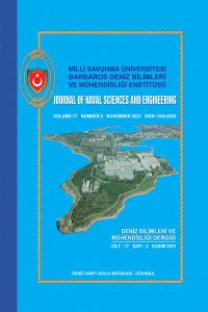PASİF DIŞ İSKELETLERİN AĞIRLIK KALDIRMAYA ETKİLERİNİN ARAŞTIRILMASI
Pasif Dış İskelet, Giyilebilir Sistemler, Yardımcı Cihazlar, Kaldırma Cihazları
INVESTIGATION OF THE EFFECTS OF PASSIVE EXOSKELETONS ON WEIGHTLIFTING
Passive Exoskeleton, Wearable Systems, Assistive Devices, Lifting Devices,
___
- Alemi, M. M., Geissinger, J., Simon, A. A., Chang, S. E., & Asbeck, A. T. (2019). A Passive Exoskeleton Reduces Peak and Mean EMG During Symmetric and Asymmetric Lifting. Journal of Electromyography and Kinesiology. https://doi.org/10.1016/j.jelekin.2019.05.003
- Baltrusch, S J, H, V. D. J., Bruijn, S. M., Koopman, A. S., M, V. B. C. A., & Houdijk, H. (2019). The effect of a passive trunk exoskeleton on metabolic costs during lifting and walking. Ergonomics, 0(0), 000. https://doi.org/10.1080/00140139.2019.1602288
- Baltrusch, S J, Koopman, J. H. V. D. A. S., Rodriguez, M. B. N. C., & Babič, G. J. (2019). SPEXOR passive spinal exoskeleton decreases metabolic cost during symmetric repetitive lifting. European Journal of Applied Physiology, 0123456789. https://doi.org/10.1007/s00421-019-04284-6
- Baltrusch, Saskia J., Van Dieen, J. H., Van Bennekom, C. A. M., & Houdijk, H. (2020). Testing an exoskeleton that helps workers with low-back pain: Less discomfort with the passive spexor trunk device. IEEE Robotics and Automation Magazine, 27(1), 66–76. https://doi.org/10.1109/MRA.2019.2954160
- Fasola, J., Vouga, T., Baud, R., Member, H. B., Bouri, M., & Member, S. (2019). Balance Control Strategies during Standing in a Locked-Ankle Passive Exoskeleton. 2019 IEEE 16th International Conference on Rehabilitation Robotics (ICORR), 593–598.
- Jia-Yong, Z., Ye, L. I. U., Xin-Min, M. O., Chong-Wei, H. A. N., Xiao-Jing, M., Qiang, L. I., Yue-Jin, W., & Ang, Z. (2020). A preliminary study of the military applications and future of individual exoskeletons. Journal of Physics: Conference Series, 1507(10). https://doi.org/10.1088/1742-6596/1507/10/102044
- Karfidova, A. O., Vasilyev, M. V., & Morozova, I. G. (2020). Modernization of an industrial passive exoskeleton prototype for lower extremities using rapid prototyping technologies. IOP Conference Series: Materials Science and Engineering, 971(5). https://doi.org/10.1088/1757-899X/971/5/052049
- Kim, S., Moore, A., Srinivasan, D., Akanmu, A., Barr, A., Harris-Adamson, C., Rempel, D. M., & Nussbaum, M. A. (2019). Potential of Exoskeleton Technologies to Enhance Safety, Health, and Performance in Construction: Industry Perspectives and Future Research Directions. IISE Transactions on Occupational Ergonomics and Human Factors, 7(3–4), 185–191. https://doi.org/10.1080/24725838.2018.1561557
- Koopman, A. S., Kingma, I., Looze, M. P. De, & Dieën, J. H. Van. (2019). Effects of a passive back exoskeleton on the mechanical loading of the low-back during symmetric lifting. Journal of Biomechanics, xxxx, 109486. https://doi.org/10.1016/j.jbiomech.2019.109486
- Lovrenovic, Z., & Doumit, M. (2019). Development and testing of a passive Walking Assist Exoskeleton. Integrative Medicine Research, 1–12. https://doi.org/10.1016/j.bbe.2019.01.002
- Luger, T., Seibt, R., Cobb, T. J., Rieger, M. A., & Steinhilber, B. (2019). Influence of a passive lower-limb exoskeleton during simulated industrial work tasks on physical load, upper body posture, postural control and discomfort. Applied Ergonomics, 80(May), 152–160. https://doi.org/10.1016/j.apergo.2019.05.018
- Pardoel, S., & Doumit, M. (2019). Development and testing of a passive ankle exoskeleton. Integrative Medicine Research, 39(3), 902–913. https://doi.org/10.1016/j.bbe.2019.08.007
- Sawicki, G. S., Beck, O. N., Kang, I., & Young, A. J. (2020). The exoskeleton expansion: Improving walking and running economy. Journal of NeuroEngineering and Rehabilitation, 17(1), 1–9. https://doi.org/10.1186/s12984-020-00663-9
- Wei, W., Wang, W., Qu, Z., Gu, J., Lin, X., & Yue, C. (2019). The effects of a passive exoskeleton on muscle activity and metabolic cost of energy. Advanced Robotics, 0(0), 1–9. https://doi.org/10.1080/01691864.2019.1707708
- Xiong, C., Zhou, T., Zhou, L., Wei, T., & Chen, W. (2019). Multi-articular passive exoskeleton for reducing the metabolic cost during human walking. 2019 Wearable Robotics Association Conference, WearRAcon 2019, 63–67. https://doi.org/10.1109/WEARRACON.2019.8719401
- Zhou, L., Chen, W., Chen, W., Bai, S., Zhang, J., & Wang, J. (2020). Design of a passive lower limb exoskeleton for walking assistance with gravity compensation. Mechanism and Machine Theory, 150, 103840. https://doi.org/10.1016/j.mechmachtheory.2020.103840
- ISSN: 1304-2025
- Yayın Aralığı: 2
- Başlangıç: 2003
- Yayıncı: Milli Savunma Üniversitesi Deniz Harp Okulu Dekanlığı
YNR GÖRÜNTÜLERİNDE KARGAŞANIN BASTIRILMASI İÇİN ÖZGÜN TENSÖR GTBA METODU
COVID-19 PANDEMİ SÜRESİNCE E-KONFERANS KABULÜNÜN BELİRLEYİCİLERİ
PASİF DIŞ İSKELETLERİN AĞIRLIK KALDIRMAYA ETKİLERİNİN ARAŞTIRILMASI
Zeynep Cansu TÜRKSELÇİ, Adnan AKKURT
COVID-19 SÜRECİNDE TOPLU TAŞIMAYI YÖNETMEK: İSTANBUL'DAKİ ETKİSİNİN VE ÖNLEYİCİ MÜDAHALENİN ANALİZİ
Muhammet DEVECİ, Nezir AYDİN, Ali Osman KUSAKCİ
DENİZ GÜVENLİĞİNİ TEHDİT EDEN YASA DIŞI EYLEMLER VE SUA SÖZLEŞMESİ
% 50 YENİLENEBİLİR ENERJİ SENARYOSU İLE TÜRKİYE’NİN ENERJİ SİSTEM SİMÜLASYONU
Emre LEBLEBİCİOĞLU, Egemen SULUKAN, Tanay Sıdkı UYAR
COVID-19’UN KÜRESEL DENİZCİLİK SEKTÖRÜNE TİCARİ ETKİSİNİN İNCELENMESİ
